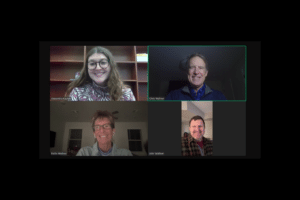In 1991, Dr. Bill Thomas was appointed as the medical director in a nursing home in upstate New York, a beautiful region filled with stunning flora and a diversity of wildlife. But the natural beauty of the area was in stark contrast to the nursing home itself, which was somehow both antiseptic and dingy, a joyless place that Dr. Thomas describes as “a repository for old people whose minds and bodies seemed dull and dispirited.” This has long been the case with how our society believes it is acceptable for older adults to live. We act as if their lives are essentially over, and their days of having fun, learning new ideas, being independent, or caring for other living things are long gone. This idea had become so ingrained in our culture that it took an act of pure inspiration to begin to think about aging differently.
Luckily, Dr. Thomas saw a system that not only devalued the contributions of older adults, but essentially dehumanized them by taking away responsibility—and decided it was time for an imaginative change. He broke society’s rules and wrote a new book on how to help others age with dignity by bringing in therapeutic plants and animals to the seniors in his care. He demonstrated that true independence can come from caring for another living, beautiful soul.
Breaking the Rules for the Greater Good
One thing that Dr. Thomas quickly realized was that, except for the residents and staff, there was no life in the nursing home. That seems like an odd realization, since we design buildings to keep nature out. But pets have always been an integral part of mankind, from the cats of Egypt to the house dogs of today. However, once you got older, it seemed, that part of your life was assumed to be over.
Dr. Thomas disagreed. He brought in dogs, cats, hens, rabbits, and about 100 parakeets, as well as hundreds of plants, for the residents to take care of. The results were transformational. The act of caring for another life gave his residents a sense of autonomy and creativity, brought them out of their “dull and dispirited” slumber, and filled them with a sense of purpose. The cost of running the home plummeted, especially the expenses for agitation medication—and, more impressively, so did the death rate.
The one problem: it was against the rules. State law forbade pets in a nursing home, possibly due to some archaic notion that stirring up the blood was a dangerous deviation from the soporific norm (or concerns about cleanliness, maybe). But soon, as the experiment became a demonstrable success, other countries like Japan and Canada began to embrace it, as did all 50 states. It was known as the Eden Alternative, and its acceptance grew across the country and around the world. Recent research has shown that 60% of nursing homes implementing these sorts of changes have seen their operating costs decline, and 70% report more patient independence, initiative, and satisfaction.
A New Definition, Not a Distraction
So why was this experiment such a success? Why did the Eden Alternative work so well? The simple explanation would be that it allowed the residents to focus on things other than growing old, but that is a shallow reading, and one that is antithetical to what Dr. Thomas preaches. See, it wasn’t a distraction, but a reorientation of the aging process as a natural aspect of the human condition.
Dr. Thomas realized that we treat aging as some kind of curse or misfortune. An anecdote he tells is that when giving lectures, he mentions he’s an old man, and then someone in the audience reassures him he isn’t. That’s a big tell—a sign that we think being old is a condition we have to fight against. Because of that, we see being old as a failure. And when we fail, we give up. We accept that life is over, and clockwatch the world go by.
But that doesn’t have to be the case. Life doesn’t stop when you are “old,” you just enter a new phase—one where you are just as alive and as vitally human as any other living soul. That’s where taking care of dogs and cats and blueberry bushes comes in. The bonds that drive us through life shouldn’t be severed as we age, and we are never too old for new bonds to be forged.
Studies show that the experience of bonding with an animal increases lifespan and health. Having an animal shakes up the routine and gives you something to care about. Gardening is great exercise, whether it is indoor or out, and simply the act of having to take care of another living being forces the mind into activity.
These are all great things, but the take away is this: they are great at any age. Having a new routine is fantastic whether you are young or old, and caring for something is always good for the mind, heart, and soul. That’s the key to Dr. Thomas’s message. It isn’t just that “having an animal is good for an older adult,” although that is part of it. It is that being an older adult is just as important a stage of life as our youth, or the years of our middle age. There is no thick line that says “life essentially ends here.” How we love and care for things—and our human desire to keep reaching for the new and exciting and stimulating—is a lifelong experiment. In breaking the rules, Dr. Thomas hopes to show us a more enlightened and compassionate view of the natural aging process.
At Institute on Aging, we strive to help every older adult live with the sense of happiness and adventure that they desire, and work to promote independent, at-home living. Connect with us today to learn more.







